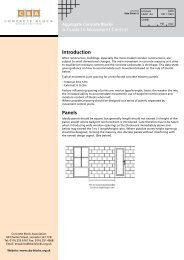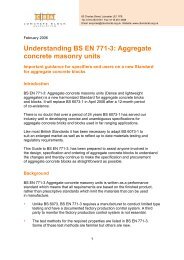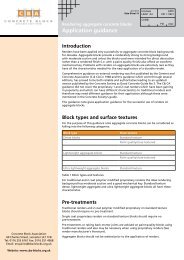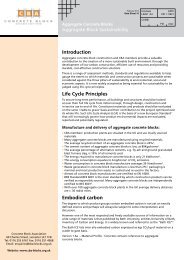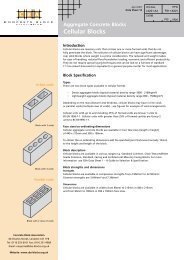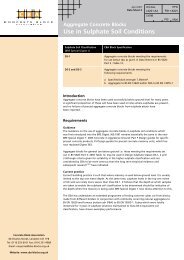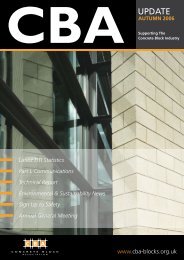Latest CBA Newsletter - Concrete Block Association
Latest CBA Newsletter - Concrete Block Association
Latest CBA Newsletter - Concrete Block Association
You also want an ePaper? Increase the reach of your titles
YUMPU automatically turns print PDFs into web optimized ePapers that Google loves.
Raising The Bar<br />
and concrete block<br />
sustainability<br />
credentials<br />
Raising the bar is a BPCF initiative to visibly<br />
improve the safety and environmental<br />
performance of precast concrete. If you<br />
are starting to turn off at this point think<br />
money instead – companies with good<br />
records on safety and environmental<br />
performance are better run and more<br />
profitable – trust me.<br />
Through records submitted to BPCF we<br />
now have a really good handle on some<br />
tangible measured key performance<br />
indicators, (kpi’s and apologies for the<br />
jargon) representing over 60% of blocks<br />
manufactured in the UK.<br />
Let us have a look at some of these and<br />
take heart at how good some of the<br />
figures already are. (Shown right)<br />
Due to the nature of manufacturing and<br />
the comparatively low product strengths<br />
blocks are one of the lowest generators of<br />
waste and the lowest category in energy<br />
usage for precast concrete. For instance<br />
tonne for tonne aircrete uses 10 times<br />
as much energy in manufacture, a figure<br />
subsequently reduced to 3 to 5 times per<br />
equivalent volume. However we could<br />
do better and what these stats give to<br />
manufacturers – that’s you – are targets<br />
to aim at and beat. If a factory’s combined<br />
energy was 50% greater than the average<br />
shown above then someone should be<br />
asking why.<br />
It should be possible to target some<br />
reductions by the end of 2014, in<br />
particular :-<br />
kWhrs per tonne of product to sub 20<br />
through investment in energy<br />
monitoring and clearly set out and<br />
followed work systems<br />
Alternative cements as a % of all<br />
cements to 25% through<br />
experimentation and investment in<br />
silo capacity<br />
Secondary aggregates as a % of all<br />
aggregates to 25%, this is currently<br />
probably an upper limit due to limited<br />
availability<br />
Litres of mains water per tonne of<br />
product to 35, by stopping leakage,<br />
wastage and by rainwater harvesting<br />
If your company has yet to fully sign<br />
up to Raising The Bar, (and it is a BPCF<br />
requirement in 2013), then I would urge<br />
you to do so. Once your figures are<br />
calculated you can compare performance<br />
against the industry standard. If you<br />
do not have the information then your<br />
performance may be Good, Bad or even –<br />
Ugly.<br />
REAP<br />
KPI Description<br />
Energy and emissions<br />
Cement content<br />
Aggregate content<br />
Packaging<br />
Water<br />
Waste<br />
Electricity and fuels<br />
Through <strong>CBA</strong> I am participating in the<br />
catchily titled Resource Efficency Action<br />
Programme For <strong>Concrete</strong> Products And<br />
Clay Bricks. This WRAP funded initiative<br />
aims to cut waste and use resources such<br />
as energy, aggregates and packaging more<br />
effectively amongst other things. The stats<br />
above will be invaluable in progressing this<br />
programme.<br />
Units quoted<br />
Fabric First<br />
<strong>Concrete</strong> block<br />
manufacture<br />
kWhr/tonne of product 21.2<br />
Kgs CO 2<br />
/tonne of product<br />
using conversion factors<br />
Total tonnes all cements/<br />
tonne of product<br />
Alternative cements as<br />
% of all cementitious<br />
materials<br />
Tonnes of all aggregates<br />
per tonne of product<br />
Secondary aggregate as %<br />
of all aggregates<br />
Kgs all packaging/tonne of<br />
product<br />
Litres mains water per<br />
tonne of product<br />
Total waste kgs/tonne of<br />
product<br />
Waste to landfill (%) of<br />
total waste<br />
Waste to landfill (kgs/tonne<br />
of product)<br />
Combined energy from<br />
all fuels and electricity all<br />
converted automatically via<br />
the input spreadsheet in to<br />
kWhrs/tonne of product<br />
6.0<br />
0.089<br />
19.3%<br />
0.884<br />
23.8%<br />
1.47<br />
39.4<br />
19.21<br />
0.56%<br />
0.11<br />
21.24<br />
I attended a conference organised by<br />
the timber frame and SIPs, (self insulated<br />
panels) industry recently. As always I was<br />
present to put the case for masonry across<br />
and was able to do that both via questions<br />
from the floor and by talking to delegates.<br />
In practice the conference was more about<br />
promoting energy efficient building fabric<br />
at the expense of so called “Ecobling”,<br />
solar panels, wind turbines, wind cowls,<br />
heat pumps, wood chip boilers and the<br />
like. It was clear that actually all makers of<br />
construction materials are facing similar<br />
challenges in pursuit of lower energy<br />
operating cost and lower carbon emitting<br />
buildings.<br />
Continued<br />
www.cba-blocks.org.uk 3




